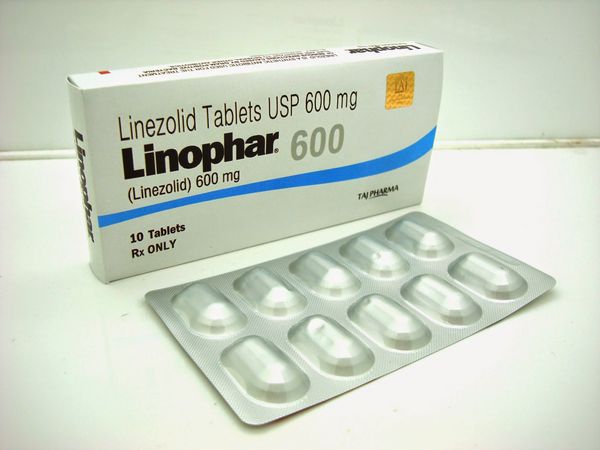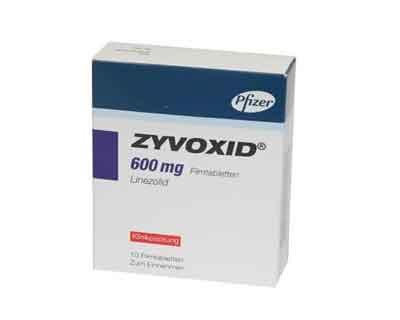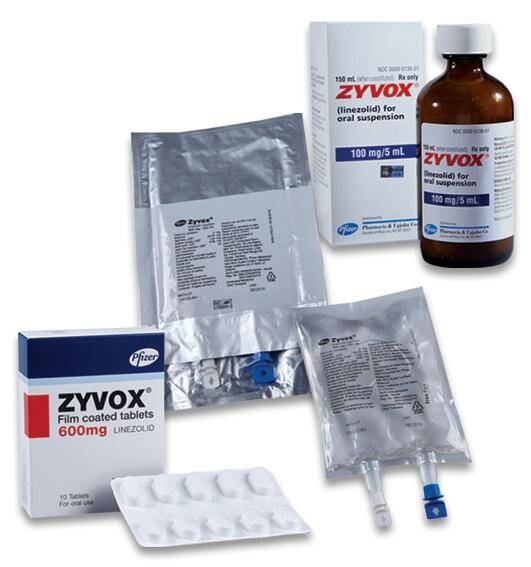Zyvox, the First in a New Class of Antibiotics
Indication: Treatment of nosocomial pneumonia, community-acquired pneumonia, complicated and uncomplicated skin and skin structure infections, and vancomycin-resistant Enterococcus faecium infections caused by indicated bacteria, in adults.

Company Name: Pharmacia & Upjohn
Availability: Approved by the FDA on April 18, 2000
Introduction
The oxazolidinones are the first new class of antibiotics to be introduced in more than 40 years, and Zyvox (linezolid) is the forerunner of this class.
Zyvox has a unique mechanism of action: It attacks bacteria at a much earlier point in their growth cycle than other antibiotics.
Zyvox, which is manufactured by Pharmacia & Upjohn, was approved by the FDA on April 18, 2000 for the treatment of patients with infections caused by Gram-positive bacteria.
Infections due to Enterococcus faecium and methicillin-resistant
Staphylococcus aureus (MRSA) are a particular problem in hospitalized or immunocompromised individuals. These organisms are often resistant to multiple antibiotics. Vancomycin has, for many years, served as the treatment of last resort for these infections. In 1989, the first case of vancomycin-resistant Enterococcus faecium (VREF) was reported in this country. Since then, there has been a rapid increase in the incidence of VREF infections, as well as a dramatic increase in the incidence of MRSA infections. There have been limited therapeutic options available for patients with these infections.
Zyvox will help clinicians battle this problem.

The drug is indicated for the treatment of nosocomial pneumonia, community-acquired pneumonia, complicated and uncomplicated skin and skin structure infections, and VREF infections caused by indicated bacteria, in adults. These indications also include approval for use in complicated skin infections caused by MRSA; nosocomial pneumonia caused by MRSA; concurrent bacteremia associated with VREF; concurrent bacteremia associated with community-acquired pneumonia caused by penicillin-susceptible Streptococcus pneumoniae.
Zyvox is available in both intravenous and oral formulations, and will be initiated primarily in the hospital or institutional care setting. Zyvox tablets are 100% bioavailable, meaning physicians can use the IV and tablet forms interchangeably without making a dose adjustment. The ability to complete treatment with an oral formulation may enable some patients to leave the hospital sooner.
How It Works
Zyvox inhibits initiation of protein synthesis by preventing the formation of the fmet- tRNA:mRNA:30S subunit ternary complex. It has also been shown that oxazolidinones bind to the 50S subunit in a region shared with the peptidyl transferase inhibitor chloramphenicol. Oxazolidinones are not peptidyl transferase inhibitors, and it is not known which specific ribosome reaction is inhibited by 50S subunit binding.
Zyvox: Clinical Study Results
Zyvox’s approval was supported by controlled clinical trials that enrolled more than 4,000 patients.
The approval for VREF infections was based on a dose-comparison study in which 145 patients were treated with Zyvox (600 mg or 200 mg) every 12 hours for VREF infection for 7-28 days.
Types of VREF infections studied included complicated intra-abdominal infections, complicated skin and skin structure infections, urinary tract infections, and bacteremia of unknown origin.
The cure rate for Zyvox was 67% in the high-dose arm and 52% in the low-dose arm. Zyvox (600 mg twice a day) was also found to be as effective as vancomycin (1 g twice a day) for treatment of hospital-acquired pneumonia, including cases due to MRSA, in a controlled clinical trial involving nearly 400 patients treated for 7-21 days. The cure rates were 57% for patients treated with Zyvox and 60% for patients treated with vancomycin.
The cure rates by pathogen were 61% (Zyvox) and 61% (vancomycin) for S. aureus; 59% (Zyvox) and 70% (vancomycin) for MRSA; and 100% (Zyvox) and 90% (vancomycin) for S. pneumoniae.
The approval for complicated skin and soft-tissue infections, including those caused by MRSA, was based on a controlled clinical trial of approximately 800 patients comparing Zyvox (600 mg injection twice daily followed by Zyvox 600 mg tablets twice daily) with oxacillin/dicloxacillin (oxacillin 2 g every 6 hours IV followed by dicloxacillin 500 mg every 6 hours orally); treatment lasted 10-21 days. The cure rates were 90% for patients treated with Zyvox and 85% for those treated with oxacillin/dicloxacillin.
What the Patient Should Know
The most frequently reported side effects attributed to Zyvox in the clinical studies were headache, nausea, diarrhea, and vomiting.
Zyvox may interact with certain other drugs, including over-the-counter cold remedies that contain pseudoephedrine or phenylpropanolamine, and cause an increase in blood pressure.
Patients receiving Zyvox should inform their physicians if they are taking such medications.

Adverse Effects and Precautions
The adverse effects most frequently reported in patients given linezolid include diarrhoea, nausea and vomiting, metallic taste, headache, insomnia, constipation, rashes, dizziness, fever, oral and vaginal candidiasis, and abnormal liver function tests. Lactic acidosis has been reported. Convulsions have also been reported in patients treated with linezolid. In some of these cases, a history of seizures or risk factors for seizures was reported.
There have been rare reports of bullous skin eruptions including Stevens-John son syndrome. Peripheral and optic neuropathy, sometimes progressing to loss of vision, have occurred rarely, mainly in patients given linezolid for more than 28 days. Visual blurring has been reported in some patients given less than 28 days of treatment. Reversible myelosuppression including anaemia, leu-copenia, pancytopenia and, in particular, thrombocytopenia has been reported and blood counts should be monitored weekly in patients receiving linezolid.
Patients particularly at risk are those who have received linezolid for more than 10 to 14 days, who are receiving other bone marrow suppressant drugs, or who have pre-existing myelosuppression or severe renal impairment. Patients with mixed (Gram-negative and Gram-positive) infections are at a higher risk of mortality when linezolid is given as monotherapy (see Increased Mortality, below); linezolid must therefore be used with appropriate antibacterial cover for Gram-negative organisms in such patients.
Effects on the blood
Reversible myelosuppression with red cell hypoplasia occurred in 3 patients treated with linezolid. Features of the myelosuppression were considered by some to be similar to those associated with chloramphenicol, although this was disputed by the manufacturers. There have been reports of thrombocytopenia occurring at a higher incidence than that reported by the manufacturers; in one study, 6 of 19 patients who had been treated with linezolid developed thrombocytopenia, while another found that it occurred in 23 of 48 patients given the drug for more than 5 days.
During the initial 8 months of licensed use in the UK 12 reports of haematopoietic disorders (including thrombocytopenia, anaemia, leucopenia, and pancytopenia) were received by the UK CSM. Studies have shown that the risk of thrombocytopenia and anaemia is increased in patients on prolonged linezolid therapy with pre-existing myelosuppression or severe renal impairment.
Effects on the eyes
See under Effects on the Nervous System, below.
Effects on mitochondria
Linezolid appears to inhibit mitochondrial protein synthesis when given for prolonged courses. This decreases cellular energy production in tissues that are highly dependent on oxidative phosphorylation, such as the optic nerve, skeletal muscles, liver, and kidneys, leading to adverse effects such as lactic acidosis or hyperlactataemia, and optic and/or peripheral neuropathy (see also below). Encephalopathy, lactic acidosis, optic neuropathy, skeletal myopathy, and renal failure were reported in a 63-year-old woman after a 4-month course of linezolid.
The symptoms resolved when linezolid was stopped; however, the patient remained blind and disorientated. In contrast, bilateral mitochondrial optic neuropathy seen in a 6-year-old boy after a 1 -year course of oral linezolid resolved 3 months after linezolid treatment was stopped. In another study reversible hyperlactataemia was reported in 5 patients given linezolid for 1 to 3 months. Mitochondrial activity and lactic acid levels returned to normal when linezolid therapy was stopped.
Effects on the nervous system
The Australian Adverse Drug Reactions Advisory Committee stated in February 2003 that it had received 4 reports of peripheral neuropathy in patients who had taken linezolid for 6 to 9 months; none of these cases had resolved at the time of the report. They suggested that the risk of peripheral neuropathy should be considered when treatment was extended beyond 28 days.
There have been several published reports of peripheral and optic neuropathy associated with linezolid, with some attributing these effects to the inhibition of mitochondrial protein synthesis by linezolid.
For further discussion see Effects on Mitochondria, above. The regulatory authority in the UK has warned that patients should be advised to report any symptoms of visual impairment immediately, including changes in visual acuity or colour vision, blurred vision, or visual field defects. Any linezolid-treated patient with new visual symptoms should be evaluated promptly and referred to an ophthalmologist if necessary; regular monitoring is advised in all patients who may require treatment for more than 28 days.
Increased mortality
In March 2007, the FDA issued an alert advising that an open-label, randomised study comparing linezolid to vancomycin, oxacillin, or dicloxacillin in the treatment of seriously ill patients with intravascular catheter-related bloodstream infections, including catheter-site infections, had found that death rates were significantly higher in patients treated with linezolid (78 of 363) than in the comparator arm (58 of 363), particularly in those with Gram-negative or mixed infections. Mortality did not differ for patients with purely Gram-positive infections.
The FDA and the UK manufacturer therefore advised that linezolid should not be used in infections caused by Gram-negative bacteria and should only be used in mixed Gram-positive and Gram-negative infections when appropriate cover for Gram-negative organisms is given at the same time. Licensed product information now reflects these warnings.
Interactions
Linezolid is a reversible, nonselective MAOI and therefore has the potential to interact with adrenergic and serotonergic drugs. Enhanced pressor activity has been reported in patients receiving linezolid with phe-nylpropanolamine or pseudoephedrine and initial doses of dopamine or adrenaline should be reduced. There have also been cases of serotonin syndrome when linezolid was taken with serotonin reuptake inhibitors, and similar symptoms when it was taken with dex-tromethorphan. The interactions of conventional MAOIs, both with other drugs and with foods, are described under Phenelzine.
Antidepressants
Serotonin syndrome has been reported in patients taking linezolid with serotonergic antidepressants such as venlafaxine and SSRIs (though concomitant use may be possible).
Opioid analgesics
For a report of an interaction between linezolid and pethidine, attributed to linezolid’s inhibitory actions on monoamine oxidase.
Antimicrobial Action
Linezolid is an oxazolidinone antibacterial with activity against a range of aerobic Gram-positive bacteria including vancomycin-resistant enterococci and meticillin-resistant Staphylococcus aureus. It is less active against Gram-negative bacteria, but has some in-vitro activity against Haemophilus influenzae, Legionella spp., Moraxella catarrhalis (Branhamella catarrhalis), Neisseria gonorrhoeae, and Pasteurella spp.
It is not active against Acinetobacter spp., Enterobacteriaceae, or Pseudomonas spp. Oxazolidinone antibacterials are bacteriostatic and act by inhibition of ribosomal protein synthesis. Cross-resistance between oxazolidinones and other classes of antibacterial is considered unlikely. Resistant strains of enterococci and meticillin-resistant Staph. aureus have been reported.
Resistance
There have been reports of linezolid resistance in enterococci, involving both Enterococcus faecium and Efaecalis There is also concern over the emergence of linezolid resistance in staphylococci, such as meticillin-resistant Staphylococcus aureus, Staph auricularis, and Staph epidermidis A survey of reported resistance to linezolid in the United States of America (USA) found that it was still rare but was no longer limited to enterococci having also occurred in Staph epidermidis and Streptococcus oralis.
Pharmacokinetics
Linezolid is rapidly and extensively absorbed after oral doses and maximum plasma concentrations are achieved after 1 to 2 hours. It is about 31% bound to plasma proteins. Linezolid is reported to be distributed into bone, fat, lungs, muscle, skin blister fluids, and into the CSF. It is metabolised mainly by oxidation to 2 main inactive metabolites, the hydroxyethyl glycine metabolite (PNU-142586) and the aminoethoxyacetic acid metabolite (PNU-142300); other minor inactive metabolites have also been identified.
About 40% of a dose is excreted in the urine as PNU-142586, 30% as linezolid, and 10% as PNU-142300. Small amounts of metabolites are excreted in the faeces. The elimination half-life of linezolid is about 5 to 7 hours. Children exhibit more rapid clearance of linezolid than adults; half-life is reported to range from about 2 to 4 hours, increasing with age.
Uses and Administration
Linezolid is an oxazolidinone antibacterial used for the treatment of Gram-positive infections of the skin and respiratory tract, including those due to vancomycin-resistant enterococci and meticillin-resistant Staphylococcus aureus. It is given, orally or by intravenous infusion (over 30 to 120 minutes), in a usual adult dose of 600 mg every 12 hours for 10 to 14 days; treatment for up to 28 days may be necessary if there is vancomycin resistance. In uncomplicated skin and skin structure infections an oral dose of 400 mg every 12 hours for 10 to 14 days is usually sufficient. For doses in neonates and children, see below.
Administration in children
UK licensed product information does not recommend the use of linezolid in children and adolescents below 18 years of age. However, the BNFC suggests the following doses of linezolid in the treatment of pneumonia or complicated skin and soft-tissue infections, given orally or by intravenous infusion over 30 to 120 minutes:
- neonates up to 7 days old: 10 mg/kg every 12 hours, increasing to every 8 hours if response is poor
- 7 days to 12 years of age: 10 mg/kg (to a maximum of 600 mg) every 8 hours
- 12 to 18 years: usual adult doses (see above).
Similar doses are licensed in the USA. US licensed product information also suggests that in the treatment of uncomplicated skin and skin structure infections, oral doses given every 12 hours are sufficient in those aged 5 to 11 years.
Administration in renal impairment
Linezolid should be used with caution in patients with renal impairment (creatinine clearance less than 30 mL/minute). Although no dosage adjustment is required, licensed product information states that peak plasma concentrations of linezolid’s two major metabolites were about tenfold higher in such patients after several days of treatment. As about 30% of a dose is removed during 3 hours of haemodialysis it is recommended that linezolid should be given after dialysis.
Mycobacterial infections
A systematic review noted that linezolid has been used with some success as an adjunct in the treatment of multidrug-resistant tuberculosis; it has also been tried in nontuberculous mycobacterial infections. However, serious adverse effects such as peripheral or optic neuropathy (in 11 of 24 patients), and anaemia (10 of 24) were observed. The review concluded that although there was limited evidence suggesting linezolid may be effective as second-line adjunct therapy for patients with mycobacterial infections, its usefulness is limited by the frequent potentially severe complications of prolonged linezolid use.
Proprietary Preparations
| Country | Medication Names |
|---|---|
| Argentina | Zyvox |
| Australia | Zyvox |
| Austria | Zyvoxid |
| Belgium | Zyvoxid |
| Brazil | Zyvox |
| Canada | Zyvoxam |
| Chile | Zyvox |
| Czech Republic | Zyvoxid |
| Denmark | Zyvoxid |
| Finland | Zyvoxid |
| France | Zyvoxid |
| Germany | Zyvoxid |
| Greece | Zyvoxid |
| Hong Kong | Zyvox |
| Hungary | Zyvox; Zyvoxid |
| India | Linospan; Linox; Lizolid |
| Indonesia | Zyvox |
| Ireland | Zyvox |
| Israel | Zyvoxid |
| Italy | Zyvoxid |
| Malaysia | Zyvox |
| Mexico | Zyvoxam |
| The Netherlands | Zyvoxid |
| Norway | Zyvoxid |
| New Zealand | Zyvox |
| Philippines | Zyvox |
| Poland | Zyvoxid |
| Portugal | Zyvoxid |
| Russia | Zyvox |
| South Africa | Zyvoxid |
| Singapore | Zyvox |
| Spain | Zyvoxid |
| Sweden | Zyvoxid |
| Switzerland | Zyvoxid |
| Thailand | Zyvox |
| United Kingdom (UK) | Zyvox |
| US (USA) | Zyvox |
| Venezuela | Zyvox |



 (10 votes, average: 3.60 out of 5)
(10 votes, average: 3.60 out of 5)












































